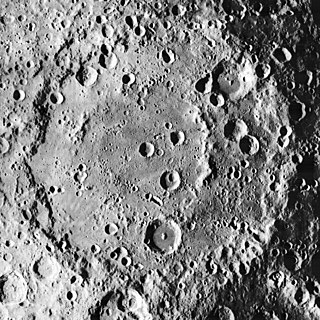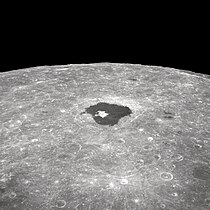
Anaxagoras is a young lunar impact crater that is located near the north pole of the Moon. It lies across the larger and more heavily worn crater Goldschmidt. To the south-southeast is Epigenes, and due south is the worn remains of Birmingham.

Aristoteles is a lunar impact crater that lies near the southern edge of the Mare Frigoris and to the east of the Montes Alpes mountain range. It was officially named in 1935 after the ancient Greek philosopher Aristotle by the International Astronomical Union, using the classical form of his name.

Metius is a lunar impact crater located in the rugged highlands to the southeast of the Moon's near side. To the southwest the rim is attached to the crater Fabricius. Offset to the west-northwest is the heavily worn crater Brenner. Further away to the northeast is the crater Rheita and the long gorge Vallis Rheita.

Plinius is a prominent lunar impact crater on the border between Mare Serenitatis to the north and Mare Tranquilitatis to the south. Its diameter is 41 km. The crater is named after the Roman natural scientist and author Pliny the Elder. To the south-southeast of Plinius is the crater Ross, and to the northeast is Dawes. Just to the north is a system of rilles named the Rimae Plinius and touching it is the Brackett crater which is more than a crater diameter north. At the northwest edge of the rille is the Promontorium Archerusia, a cape off the western rim that encloses the Mare Serenitatis.

Al-Khwarizmi is a lunar impact crater located on the far side of the Moon. It lies to the southeast of the crater Moiseev, and northeast of Saenger.

Petavius is a large lunar impact crater located to the southeast of the Mare Fecunditatis, near the southeastern lunar limb. Attached to the northwest rim is the smaller crater Wrottesley. To the southeast are Palitzsch, Vallis Palitzsch, and Hase. Farther to the north is the large crater Vendelinus. Petavius appears oblong when viewed from the Earth due to foreshortening. Petavius is Imbrian in age.

Gassendi is a large lunar impact crater feature located at the northern edge of Mare Humorum. It was named after French astronomer Pierre Gassendi. The formation has been inundated by lava during the formation of the mare, so only the rim and the multiple central peaks remain above the surface. The outer rim is worn and eroded, although it retains a generally circular form. A smaller crater – Gassendi A – intrudes into the northern rim, and joins a rough uplift at the northwest part of the floor. The crater pair bear a curious resemblance to a diamond ring.

Eudoxus is a prominent lunar impact crater that lies to the east of the northern tip of the Montes Caucasus range. It is named after the Greek astronomer Eudoxus of Cnidus. It is located to the south of the prominent crater Aristoteles in the northern regions of the visible Moon. To the south is the ruined formation of Alexander, and the small crater Lamèch lies to the southwest.

Korolev is a large lunar impact crater of the walled plain or basin type. It is a basin of Nectarian age.

Archytas is a lunar impact crater that protrudes into the northern edge of Mare Frigoris. To the northwest is the comparably sized crater Timaeus, and the smaller Protagoras lies in the opposite direction to the southeast. Further to the southwest, beyond the opposite edge of the mare, is the dark-floored crater Plato.

Milne is a large lunar crater that is located in the southern hemisphere on the far side of the Moon, named after the British mathematician and astrophysicist Edward Arthur Milne. It lies to the northeast of the Mare Australe, and southeast of Lacus Solitudinis.

Mendeleev is a large lunar impact crater that is located on the far side of the Moon, as seen from the Earth. The southern rim of this walled plain just crosses the lunar equator. Intruding into the eastern rim of Mendeleev is the crater Schuster. Nearly on the opposite side, the smaller Hartmann intrudes into west-southwestern rim.

Pasteur is a large lunar impact crater, approximately 233 kilometers in diameter, belonging to the category termed a walled plain. It was named after French chemist and microbiologist Louis Pasteur. It lies on the far side of the Moon as seen from the Earth, just beyond the eastern limb. The vicinity of this crater is occasionally brought into view from Earth due to librations, although not much detail can be seen.

Chaplygin is a large lunar impact crater that lies on the far side of the Moon. It is located to the southeast of the huge walled plain Mendeleev, about midway between the craters Schliemann to the northeast and Marconi to the southwest. It is about the same size as Albategnius on the near side.

Congreve is a lunar impact crater that is located on the far side of the Moon relative to the Earth, and lies across the lunar equator. It lies to the west-northwest of the massive walled plain Korolev. To the southeast is the crater Icarus, and due north is Zhukovskiy.

Necho is a lunar impact crater on the far side of the Moon, and therefore cannot be seen directly from the Earth. It lies to the northeast of the larger crater Langemak, about a crater diameter to the south-southwest of Bečvář and further east is Love.

Kohlschütter is a lunar impact crater that cannot be viewed directly from the Earth as it lies on the Moon's far side. It is located a couple of hundred kilometers to the southeast of the Mare Moscoviense, and due south of the smaller crater Nagaoka. It is a relatively isolated formation surrounded by a multitude of smaller impacts typical of the battered far side.

Rocca is a lunar impact crater that is located near the western limb of the Moon. It lies to the northwest of the flooded crater Crüger, and to the west of the Montes Cordillera. Just to the east-southeast of Rocca is the small Lacus Aestatis, a small lunar mare.

Van den Bos is a small lunar impact crater that is joined to the south-southwestern outer rim of the slightly larger crater Tamm. About one crater diameter to the west is Vil'ev. Farther away to the east is the prominent Chaplygin, and to the south-southwest lies Marconi. van den Bos is located on the far side of the Moon and cannot be viewed directly from the Earth.

Tamm is a shallow lunar impact crater. It is located to the west-northwest of the much larger and more prominent crater Chaplygin. Attached to the south-southwestern outer rim of Tamm is the smaller van den Bos. There is a gap in the southern rim where these two craters are joined together.



























